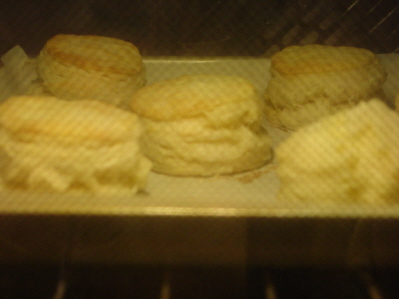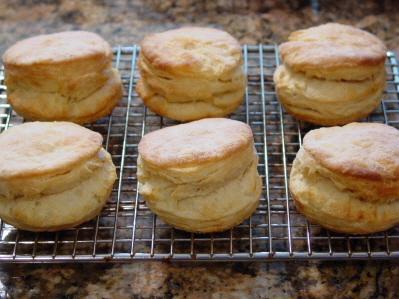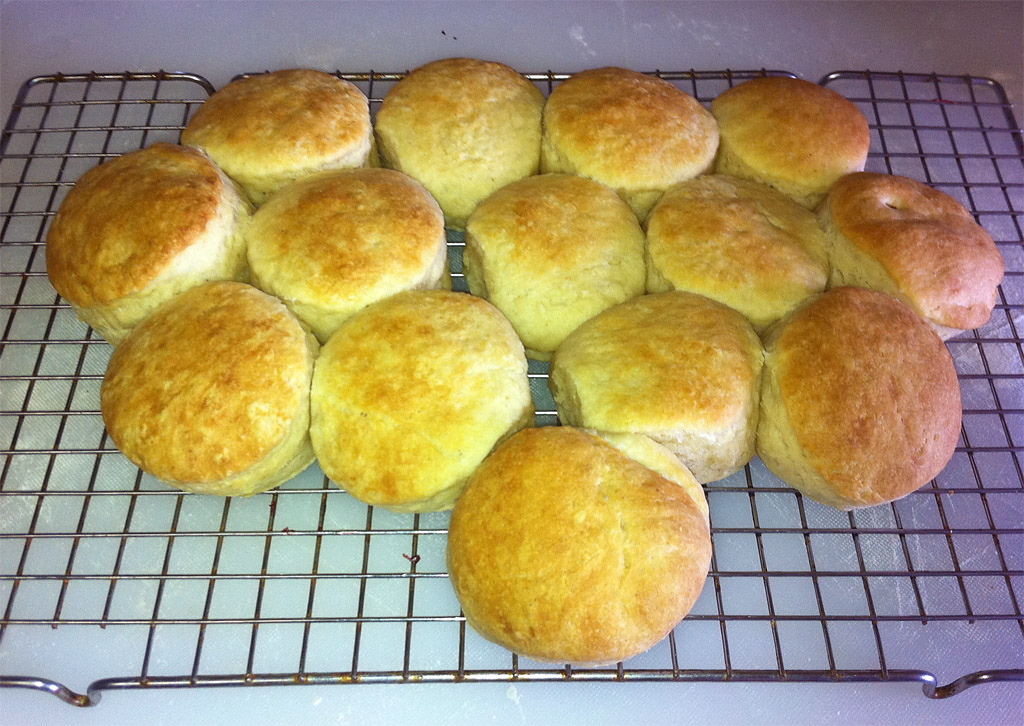
Yes, that's right... baking powder. I'll bet you've never given it much thought before. I know I hadn't. I mean, I know there are basically two kinds---aluminum-based (I call that "regular") and aluminum-free, right? I assumed all aluminum-based baking powders were pretty much the same, and all non-aluminum powders the same. But it turns out that I was wrong on both counts. My recent foray into biscuit-making and quest for cloud-like loftiness, inspired me to do a little informal research into the science of chemical leavening.
It all started with the Flaky Buttermilk Biscuits I baked one night to go with a big pot of homemade vegetable beef stew. I was still on the hunt for a biscuit recipe that I could be happy with, so I turned to the mini library of Cooks Illustrated hard-bound annuals housed in my living room bookcase. CI has several biscuit recipes to choose from, but since I had never laminated them before, I thought the flaky type might be worth a shot.
The only real decision to make was which baking powder to use. Being an avid baker, I keep a selection in my pantry---aluminum-based for when a strong rise really counts, and aluminum-free for when the taste would otherwise overpower. I decided on Clabber Girl, because I can't really remember what's in the glass jar. I think it is Bakewell Cream Baking Powder, which would have been a good choice, except that has a relatively short shelf life and its age is questionable. Rumford is my favorite for cakes, but not much else. So, Clabber Girl it was.
I was both thrilled and impressed with the recipe, for its high rise and many layers. But I was disappointed in the flavor, which closely resembled "biscuits-in-a-can." In other words, a very strong baking powder taste, owing of course, to the full tablespoon of baking powder called for in the recipe. I thought, no problem, I'll just use half Clabber Girl and half Rumford next time. I do that for some things, to get the best of both. But the rise was only mediocre by comparison. Rumford is aluminum-free and gives me great results in butter cakes, but it seems to fizzle too soon in some of my quickbreads, and wears itself out in the mixing bowl---especially when buttermilk is in the mix.
Left: Clabber Girl
Right: Rumford-Clabber Girl combo
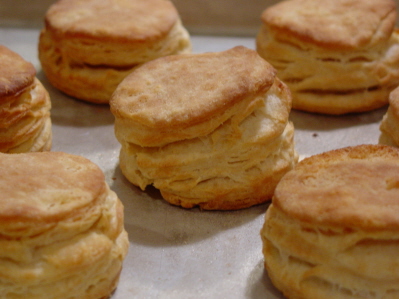
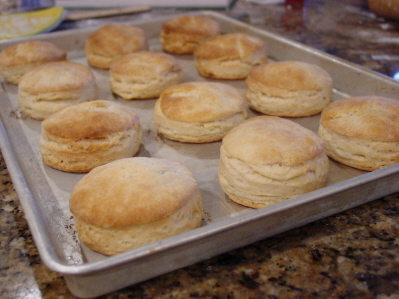
At this point, I started wondering about (Original) Bakewell Cream, which is billed in The Baker's Catalog as the "secret ingredient" for biscuits. I checked around a bit on the Internet, and it does indeed receive very high marks by the New England biscuit makers in its limited distribution area. If this is really THE biscuit leavener, then really... don't I need to try it? So, I bit the bullet and placed an order.
While waiting for the Bakewell Cream to arrive, I turned my attention to Calumet. This is the one I grew up with. Once widely available, it is getting harder and harder to find around here. I searched four stores before finally scoring myself some. It gave my biscuits better flavor than the Clabber Girl, but the rise was not much better than the half-and-half Clabber Girl-Rumford combination. Perhaps that's a clue as to its formulation.
But the exciting thing was, that while on my mission to find Calumet, I stumbled upon a new baking powder. Well, it's new around here anyway, and I had never seen or heard of it before (plus, it says "New!" right on the label). I'm talking about Argo Baking Powder; have you seen it? Yep, it's the same people who make the cornstarch. What's so exciting about this baking powder, is that it has the same active ingredient as the Bakewell Cream, and unlike Rumford, it is a true double-acting, aluminum-free baking powder.
What does that mean? What makes all these baking powders different, you're wondering? Well, the basic equation is the same for all: baking soda + acid = lift. In the presence of moisture, baking soda reacts chemically with the acid, and CO2 bubbles released in the process make a batter or dough rise. Baking soda is the constant, but there are an array of acids to choose from, which can be sorted into two distinct categories---fast-acting, and slow-acting.
Fast-acting are acids that work at room temperature. They react in the mixing bowl when dry and liquid ingredients are combined, to give "bench rise." A good example is cream of tartar, which was used in the first commercial baking powders, and is still used in homemade preparations. The fast-acting acid ingredient preferred in commercial baking powders today is monocalcium phosphate (MCP).
Slow-acting acids don't react right away. They require heat to get going, and don't start reacting until the batter or dough reaches at least 120 degrees F. This is called "oven rise." Slow-acting acids include: sodium aluminum sulfate (SAS), sodium aluminum phosphate (SALP) and sodium acid pyrophosphate (SAPP).
A baking powder is said to be single-acting if it contains only one acid. If the acid is fast-acting, then the baker will need to get the batter mixed and into the oven very quickly---before it loses its bubbles or it won't bake as high. A double-acting baking powder includes both fast- and slow-acting acids. These are designed to create carbon dioxide gas more slowly, and over a longer period of time. Some bench rise during mixing is advantageous in creating bubble structure, for things like butter cakes, pancakes and waffles. However, a strong oven rise appears to be more important for things like biscuits and cornbread.
Here is a breakdown of the baking powders I tested, and a couple others that aren't available to me locally:
If you've stuck with me this far, you probably want to know how the Bakewell Cream measured up against Argo and the rest of the powders. I have to say that Bakewell Cream's lift rivaled that of Clabber Girl, but the flavor was a whole lot better. You have to combine Bakewell Cream---which is just an acid---with your own baking soda, to create the baking powder effect. Some may find the extra measuring a nuisance, but the advantage is that, unmixed, it keeps indefinitely. Baking powders, on the other hand, have a limited shelf life of about a year.
The Argo biscuits baked up just as light as the Bakewell Cream, so I almost had to declare this one a tie. But Argo eked out the win based on flavor (and the fact that I don't have to mail-order it---not that I wouldn't for something that is truly better). The flavor thing was such a close call, though. I really thought they would taste the same, and had I not had the opportunity to have them side-by-side, I wouldn't have noticed the very slight difference. That's how close it was. So for the lightest, best-tasting biscuits, I would say, opt for something with sodium acid pyrophosphate (SAPP) in the ingredient list. If there is a secret ingredient, that would be it. -Debra Wink
Left: Argo biscuits, baking
Right: Bakewell Cream biscuits, cooling
